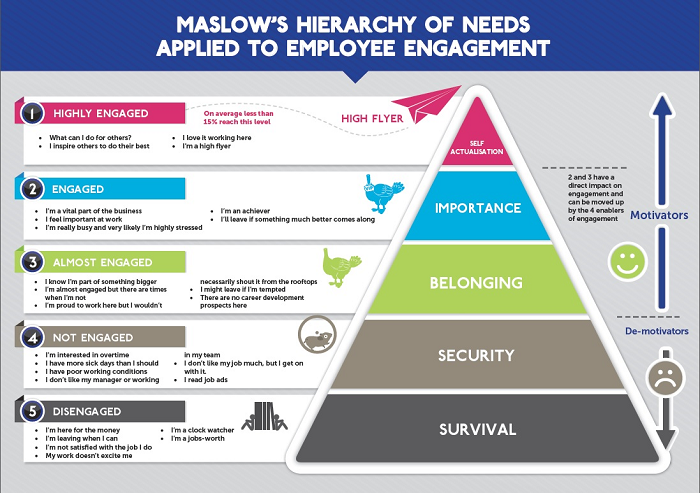
Employee engagement is crucial: it ensures your staff is committed to your organization’s values and goals and helps everyone buy-in to your organization’s overall mission. Employees that are happily engaged in the workplace are more motivated to contribute to your organization’s success.
The problem is, according to Gallup, only 30 percent of American workers are engaged at work, meaning the nation loses $450 to $550 billion per year in lost productivity.
The Spectrum of Engagement
Before we talk about boosting employee engagement, it’s important that we first discuss the range of engagement per Abraham Maslow’s hierarchy of needs model. Let’s start from the worst-case scenario to the best.
Completely Disengaged Employees
Disengaged employees are in survival mode. Their main motivation for coming to work is for the money. They tend to be clock-watchers and leave as soon as they’ve put in the required amount of time. They’re not excited about their work and they’re not satisfied with the job. Is anyone in your organization in survival mode?
Unengaged Employees
These employees are a bit more engaged than those that are completely disengaged, but not by much. Their main motivation to stay is job security. These employees don’t like their job very much, but “get on with it,” may have poor working conditions, and don’t like their manager or working with their team. They’re also disproportionately interested in overtime, take more sick days than the average employee, and read job ads regularly.
Almost Engaged Employees
These employees feel a sense of belonging in the workplace and are almost engaged, but are still sometimes disengaged. They know they’re a part of something bigger and are proud to work with you, but not enough to “shout it from the rooftops.” Because there are few, if any, career development prospects at their current jobs, they might leave if tempted.
Engaged Employees
Engaged employees feel a sense of importance and that they’re a vital part of the business. They’re achievers and feel important at work. They’re also very busy and therefore likely to have high stress levels, but will only leave the company if something much, much better comes along.
Highly Engaged Employees
On average, less that 15 percent of employees reach this level of engagement. These high flyers are self-actualized, love working at their company, inspire others to do their best, and ask themselves what they can do for other employees.

Boosting Engagement
Now that you know the five different levels of engagement, it’s time to learn how you can boost it at your own organization.
Many articles on this subject will simply tell you to hand out surveys, but that simply won’t cut it. In order to really understand how your employees feel and what they’re struggling with, you’ll need to sit them down and have meaningful conversations.
Here are some important topics to relay during, as well as important steps to take after, those conversations.
Define Your Purpose
If you don’t completely, 100 percent understand your organization’s purpose, you can’t relay it, and others can’t get on board with it.
If you haven’t taken a deep dive into why your department or organization exists and its core purpose, you can’t expect your employees to know those things either.
If you haven’t already, take a full day to sit down and discuss these things with your key managers or senior management team. Some things will be redundant, while others may surprise you. At the end of the day, make sure you’re all on the same page with a clearly defined and well-articulated purpose that you can then discuss with employees.
Start at the Top
Real change in employee engagement levels can only be expected if you’re implementing your strategies from the top down.
If you expect entry-level employees to be engaged and buy-in to your department or organization’s purpose, it’s important that the most senior level employees do too.
Implement initiatives—whether they be team-building exercises or communication workshops—from the top, down. This will help improve transparency, make engagement more of a team effort, and allow employees to make a difference in their immediate environments.
Choose Managers Carefully
It takes a certain talent and a specific skill set to be great at managing other people. Great managers increase the odds of engaging their employees because they understand that the success of the organization depends on each employee’s achievement.
Your managers should care about the success of those on their respective teams and understand each individual’s unique strengths. Their ability to seek employee ideas and opinions, recognize and value their contributions, and empower team members can greatly increase the level of employee engagement.
Conclusion
As New York Times bestselling author Daniel Pink explains, “What we really want in our jobs is autonomy, the chance to get better at what we do, and a purpose that connects us to something larger.”
By understanding to what degree your employees are engaged and actively working to improve their work experience, you’ll relay that you’re invested in them and their futures.
Ultimately, engaging your employees is critical to the success of your business because the more engaged they are, the happier your customers will be.
Do you have more thoughts on employee engagement? Can you share any success stories involving engaging employees?



